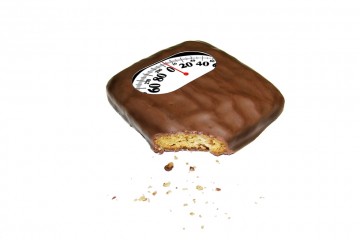How to Prepare Biggest Loser Meal Plans
The Biggest Loser diet includes easy-to-follow meal plans that encourage frequent eating. The meal plans are also structured to ensure that you receive balanced nutrition that is geared to help you lose weight.
Steps
Method 1 Understand the Basics
In addition to knowing your daily calorie allowance, you will also follow The Biggest Loser Pyramid. The pyramid contains the amount of servings that you can have each day from the different food groups.
- 1 Determine your daily calorie allowance. Multiply your current weight times 7 to find your daily calorie target. If you weigh 200 pounds, for example, your target would be 200 x 7 or 1,400 calories.
-
2
Eat a minimum of 4 servings of fruits and vegetables daily.
- Make sure that at least half of your servings are from vegetables; don’t eat more fruits than vegetables.
- One serving equals 1 cup, 1 medium piece or 8 ounces (227 g) of a fruit or vegetable.
-
3
Eat 3 servings of protein daily.
- Meat, low-fat dairy or vegetarian protein sources are all acceptable.
- Appropriate serving sizes are 1 cup or 8 ounces (227 g).
-
4
Enjoy 2 servings of whole grains daily. Serving sizes are as follows:
- Bread: 2 slices of light bread, 1 whole-grain bun, 2 light crisp bread (Wasa) flatbreads, 1 whole-wheat flour tortilla
- Grains: 1 cup of cooked barley, brown rice, couscous or other grains
-
5
Use your allowance of 200 additional calories. Good foods for your optional calories include:
- Fats, Oils and Spreads: Good fats like olive, canola, flaxseed and olive oils; reduced-fat nut butters; and reduced-fat salad dressings and mayonnaise
- Sugar-free Desserts and Sweets: Puddings and gelatins; jams, jellies and syrups; popsicles and fudgesicles; whipped topping
- Reduced-fat dairy: Low-fat or fat-free cheese or sour cream
- Condiments and sauces: Condiments like ketchup and mustard, barbecue sauce, Worcestershire sauce, light soy sauce, salsa and Tabasco sauce
Method 2 Follow the Meal Plan
You will eat 3 meals per day as well as 2 to 3 snacks. Each meal has a particular ratio of nutrients to provide you with both structure and recipe ideas.
-
1
Eat a healthy breakfast.
- You will eat 1/2 of a protein serving, 1 whole grain serving and 1 fruit serving for breakfast.
- A sample breakfast could be 1/2 cup egg whites, 2 slices of whole grain toast and 1 cup of sliced cantaloupe.
-
2
Enjoy more protein at lunch.
- At lunch, you will eat 1 serving of protein, 1/2 serving of whole grains and 1 serving of vegetables.
- For example, you could eat a bulgur salad made with 4 ounces of grilled chicken breast, 1/2 cup of cooked bulgur and 1 cup of diced grilled vegetables.
-
3
Fill up on vegetables during dinner.
- You will eat 2 cups of vegetables for dinner in addition to 1/2 serving each of protein and whole grains.
- For example, you can enjoy 4 ounces of grilled salmon, 1/2 cup of brown rice and 2 cups of tossed salad.
-
4
Enjoy 2 to 3 snacks. The number of snacks that you eat will depend on your daily calorie allowance.
- Each snack should consist of 1/2 protein serving and 1 fruit serving.
- A sample snack could be 1/2 cup of reduced-fat cottage cheese and 1 cup of diced pineapple.
-
5
Use your optional calories wisely.
- Add salsa to your egg whites at breakfast or add a reduced-fat salad dressing to your dinner.
- The calories should be used sparingly to add flavor to your meals and snacks.
Method 3 Fruits and Vegetables
You can exceed your allotment of fruits and vegetables if you wish as long as you don’t eat extra servings of starchier vegetables like pumpkin, winter squash, sweet potatoes and yams.
- 1 Enjoy fresh fruits and vegetables. If you need to eat frozen or canned fruits and vegetables, watch the sugar, syrup and sodium content.
- 2 Cook vegetables for the shortest amount of time possible. This will help to preserve the nutrient content.
- 3 Choose whole fruits instead of fruit juices.
- 4 Avoid dried fruits.
- 5 Avoid potatoes.
- 6 Try a new fruit or vegetable each week. This will help to build some variety into your diet.
Method 4 Proteins
Proteins will include animal-based foods, beans and legumes, soy and low-fat dairy products. Proteins help you to feel full and satiated, which helps to prevent binge eating.
- 1 Choose a variety of proteins to consume each day. Choose animal proteins including lean meats and fish, vegetarian protein such as beans/legumes and soy, and low-fat dairy such as yogurt, skim milk and cottage cheese. Try to eat one protein from each category daily.
- 2 Limit red meat servings to 2 per week, as these tend to be high in saturated fat.
- 3 Look for free-range or grass-fed meat options.
- 4 Look for wild caught instead of farm-raised fish.
- 5 Avoid processed meats like bologna or hot dogs.
- 6 Remove the skin before you consume poultry to significantly lower the fat content.
Method 5 Whole Grains
Whole grains contain fiber, which helps to promote a feeling of fullness, as well as many nutrients. Choose high-fiber grains and grain-based foods that have been minimally processed.
- 1 Choose the least processed grain options available. For instance, brown rice undergoes less processing than white rice, so it retains much of its nutritional value.
-
2
Choose breads with 2 or more grams of fiber per serving.
- Read the labels of breads to ensure that the first listed ingredient is “whole grain” or “whole wheat flour.”
- Avoid foods containing primarily “enriched” flour.
- 3 Stick to packaged cereals that contain 5 or more grams of fiber per serving. Avoid packaged cereals that contain processed flour and added sugar.
Method 6 The Extras: Your 200-Calorie Budget
Every day, you can use these calories to add flavor to your meals. Be sure that you don’t waste these calories on sugary foods or other indulgences that will hinder your weight loss.
- 1 Avoid saturated fat, which is found in some animal products, in egg yolks and in full-fat dairy, as well as trans fats, which are found in foods containing hydrogenated oil.
- 2 Do not rely on reduced-fat, sugar-free, fat-free and low-carb products that have been highly processed. Focus on whole foods rather than on “diet foods.”
- 3 Make use of spices and herbs, which pack flavor into meals without added calories or sodium.
- 4 Choose condiments that are low in calories and sodium. Low-calorie condiments will help you to reduce your calorie intake, and low-sodium condiments will keep you from retaining water.
-
Simple And Effective Tips To Lose Weight
Often, you find yourself losing a few pounds only to reach a certain
-
Expert Weight Loss Ideas That Can Help You Succeed
You’ve tried many diets but they have never worked- does th
-
How to Workout at Home Using Hand Weights
Sometimes its just way more convenient to work out at home instead of
-
How To Burn More Fat When Youre Exercising
So you’re stuck at the same weight and no matter what you do, you can
-
How Do Online Weight Loss Programs Work?
If youre interested in losing weight and want to try an online progra
-
Fast Weight Loss Tips For Long Term Success
Most of the fast weight loss tips that you will see on the internet w
- DON'T MISS
- 7 weight loss tips for Christmas
- How to Lose Weight With the Hcg Diet
- Weight Loss Tip #35: Eat more fibre to lose weight
- Boost Your Metabolism Quickly For Weight Loss
- Another Look at Goals and Fitness
- Tips For Making Weight Loss Fast And Simple
- Weight Loss Tip #79 – Practice fast-paced yoga styles
- Most Optimized and Active Solutions to Weight Loss
- Weight loss tip: Enjoy your Meal
- This Is What Happens To Your Body When You Skip Meals




